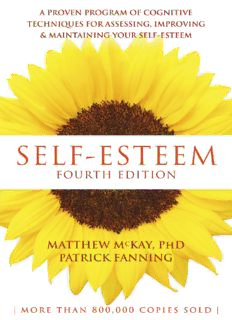
Self-Esteem: A Proven Program of Cognitive Techniques for Assessing, Improving, and Maintaining Your Self-Esteem PDF
Preview Self-Esteem: A Proven Program of Cognitive Techniques for Assessing, Improving, and Maintaining Your Self-Esteem
“McKay and Fanning recognize the complexity of the human tendency toward self-criticism. Their carefully written, cognitively oriented self-help book wisely avoids simplistic solutions, offering instead a systematic approach to self- esteem development.” —Robert E. Alberti, PhD, author of Your Perfect Right “Positive self- esteem is the centerpiece of a healthy personality. McKay and Fanning’s book offers us a valuable storehouse of tactics and strategies for constructing—or renovating—the foundation of our self-esteem.” —Philip G. Zimbardo, PhD, author of Shyness “Self-Esteem is truly a very special title. Good writing is especially necessary for self-help titles. … I feel a special enthusiasm in bringing it to the notice of our audience.” —The Midwest Book Review Publisher’s Note This publication is designed to provide accurate and authoritative information in regard to the subject matter covered. It is sold with the understanding that the publisher is not engaged in rendering psychological, financial, legal, or other professional services. If expert assistance or counseling is needed, the services of a competent professional should be sought. Distributed in Canada by Raincoast Books Copyright © 2016 by Matthew McKay and Patrick Fanning New Harbinger Publications, Inc. 5674 Shattuck Avenue Oakland, CA 94609 www.newharbinger.com Cover design by Amy Shoup Acquired by Melissa Valentine Edited by Gretel Hakanson All Rights Reserved Library of Congress Cataloging-in-Publication Data on file To my loving parents, Bert and Grace Fanning —P. F. In memory of my father, George Edward McKay —M. M. Grateful acknowledgment is made to Eugene B. Sagan, PhD, who introduced me to the pathological critic and some of the important techniques used in this book. —M. M. Contents CHAPTER 1: THE NATURE OF SELF-ESTEEM Causes and Effects How to Use This Book For the Therapist An Issue of Diagnosis Cognitive Restructuring for Self-Esteem CHAPTER 2: THE PATHOLOGICAL CRITIC An Arsenal of Shoulds The Origin of the Critic Why You Listen to the Critic The Role of Reinforcement The Variable-Ratio Reinforcement Schedule How the Critic Gets Reinforced Positive Reinforcement for the Critic Negative Reinforcement for the Critic Catching Your Critic CHAPTER 3: DISARMING THE CRITIC Unmasking His Purpose Talking Back Making Your Critic Useless Summary Chart CHAPTER 4: ACCURATE SELF-ASSESSMENT Self-Concept Inventory Listing Your Weaknesses Listing Your Strengths A New Self-Description Celebrate Your Strengths CHAPTER 5: COGNITIVE DISTORTIONS The Distortions 1. Overgeneralization 2. Global Labeling 3. Filtering 4. Polarized Thinking 5. Self-Blame 6. Personalization 7. Mind Reading 8. Control Fallacies 9. Emotional Reasoning Combating Distortions The Three-Column Technique Creating Your Rebuttal Voice Rules for Rebuttal Rebuttals 1. Overgeneralization 2. Global labeling 3. Filtering 4. Polarized thinking 5. Self-blame 6. Personalization 7. Mind reading 8. Control fallacies 9. Emotional reasoning CHAPTER 6: DEFUSING PAINFUL THOUGHTS Watching Your Thoughts Letting Go of Thoughts Combining Watching, Labeling, and Letting Go Distancing from the Critic Example: Tony and the Three Questions CHAPTER 7: COMPASSION Compassion Defined Understanding Acceptance Forgiveness Toward a Compassionate Mind The Compassionate Response The Problem of Worth Affirming Your Worth Compassion for Others Empathy CHAPTER 8: THE SHOULDS How Values Are Formed The Tyranny of the Shoulds Healthy Versus Unhealthy Values How Shoulds Affect Your Self-Esteem Discovering Your Shoulds Challenging and Revising Your Shoulds Cutting Off the Should Atonement—When Shoulds Make Sense CHAPTER 9: ACTING ON YOUR VALUES Life Domains Ten Weeks to Put Values into Action Planning Committed Action CHAPTER 10: HANDLING MISTAKES Reframing Mistakes Mistakes as Teachers Mistakes as Warnings Mistakes: Prerequisite for Spontaneity Mistakes: The Necessary Quota Mistakes as Nonexistent in the Present The Problem of Awareness Responsibility The Limits of Awareness The Habit of Awareness Raising Your Mistake Consciousness CHAPTER 11: RESPONDING TO CRITICISM The Myth of Reality A TV Screen in Every Head Screen Inputs Innate constitution Physiological state Emotional state Habitual behavior patterns Beliefs Needs The Screen as Monster-Maker Mantra for Handling Criticism Responding to Criticism Ineffective Response Styles Aggressive style Passive style Passive-aggressive style Effective Response Styles Putting It All Together CHAPTER 12: ASKING FOR WHAT YOU WANT Your Legitimate Needs Needs Versus Wants Wants into Words Distilling the Assertive Request Whole Messages Your Thoughts Your Feelings Putting It Together Rules for Requests CHAPTER 13: GOAL SETTING AND PLANNING What Do You Want? Question 1: What Hurts or Feels Bad? Question 2: What Are You Hungry For? Question 3: What Are Your Dreams? Question 4: What Are the Little Comforts? Selecting Goals to Work On: The First Cut Selecting Goals to Work On: The Evaluation Making Your Goals Specific Making Mental Movies Listing the Steps Making a Commitment Blocks to Achieving Goals Insufficient Planning Insufficient Knowledge Poor Time Management 1. Prioritize 2. Make To Do Lists 3. Say “No” Unrealistic Goals What are the odds? Fear of Failure Fear of Success CHAPTER 14: VISUALIZATION Why Visualization Works Visualization Exercises Rules for Creating Effective Self-Esteem Visualizations Self-Esteem Sessions
Description: